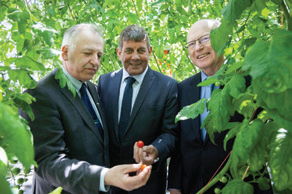

Teagasc’s new development of horticulture, forestry and education facilities at its campus in Ashtown, Dublin were officially opened on Thursday, 17 May by Andrew Doyle TD, Minister of State at the Department of Agriculture, Food and the Marine.
Over €2.1 million has been invested in facilities including a modern glasshouse equipped with advanced systems for research, a turfgrass academy, a horticultural utility building, a large multi-span forestry polytunnel and additional polytunnels and structures which have various specific uses. The other primary piece of infrastructure on the site is the mushroom research unit, which has 100m2 of growing area to support a dedicated mushroom research programme. These new facilities underline a Teagasc commitment to the horticulture sector and complement already existing facilities on the Ashtown campus, including a conference centre and facilities associated with the food research programme.
This investment followed a decision taken as part of the Teagasc change programme which saw the Teagasc Kinsealy campus close and horticulture, forestry and education activities moved to the Ashtown campus, where Teagasc already has a food research centre. The investment was funded through the disposal of Teagasc assets and Teagasc funding from the government.
The upside to embedding the horticulture development department, and ultimately the horticulture research programme, in the Ashtown campus will be threefold: the opportunity to conduct research and development in new state of the art facilities will be more appropriate to current commercial requirements; the increased capacity that the Ashtown site provides to cross-pollinate with the food research programme cannot be underestimated; opportunities to develop synergies with horticulture education and forestry colleagues on the site are evident. ✽







